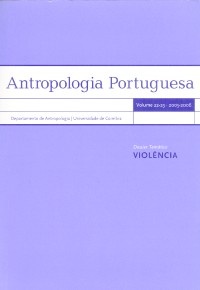Please use this identifier to cite or link to this item:
https://hdl.handle.net/10316.2/29280| DC Field | Value | Language |
|---|---|---|
| dc.contributor.author | Cunha, Eugénia | - |
| dc.contributor.author | Pinheiro, João | - |
| dc.date.accessioned | 2014-02-12T10:01:47Z | |
| dc.date.accessioned | 2020-09-15T08:02:30Z | - |
| dc.date.available | 2014-02-12T10:01:47Z | |
| dc.date.available | 2020-09-15T08:02:30Z | - |
| dc.date.issued | 2006 | - |
| dc.identifier.issn | 2182-7982 | - |
| dc.identifier.uri | https://hdl.handle.net/10316.2/29280 | - |
| dc.description.abstract | Because bones are among the most resistant material of the human body they have the capacity to save some events occurred during life, at the time of death and even after death. Traumatic injuries are among the most informative skeletal marks making them a unique source about violence. To read the fracture’s language is a forensic anthropologist paramount task. The traumatic lesions associated with the time of death can be particularly violent, the reason why they will be approached in the present article, namely gunshot wounds, blunt force trauma and sharp force trauma. Each of these perimortem injuries will be discussed within the context of cause and manner of death. In order to provide a better insight to each of these types, some concepts of bone biomechanics as well as some practical cases will be given. | eng |
| dc.description.abstract | Os ossos, o material mais resistente do corpo humano, têm uma capacidade ímpar para registar muitos episódios ocorridos em vida, na altura da morte e até mesmo depois da morte. As lesões traumáticas estão entre as marcas deixadas nos ossos mais informativas, o que faz delas uma fonte única de registos sobre violência, cabendo ao antropólogo forense a tarefa de as decifrar. As lesões traumáticas relacionadas com a morte são as mais violentas, razão pela qual foram as seleccionadas para desenvolver no presente artigo, designadamente as provocadas por arma de fogo, os traumas de natureza contundente e as lesões incisas ou cortantes. Cada uma destas lesões perimortais é abordada no contexto da determinação da causa da morte ou da etiologia médico‑legal. Para uma melhor interpretação de cada um destes tipos, são abordados alguns conceitos de biomecânica das lesões e referidos alguns casos práticos ilustrativos. | por |
| dc.language.iso | por | - |
| dc.publisher | CIAS - Centro de Investigação em Antropologia e Saúde | - |
| dc.rights | open access | - |
| dc.subject | Fractures | eng |
| dc.subject | Fracturas | por |
| dc.subject | morte | por |
| dc.subject | violência | por |
| dc.subject | perimortais | por |
| dc.subject | antropologia forense | por |
| dc.title | A linguagem das fracturas: a perspectiva da Antropologia Forense | por |
| uc.publication.collection | Antropologia Portuguesa vol. 22/23 | - |
| uc.publication.firstPage | 223 | - |
| uc.publication.lastPage | 243 | - |
| uc.publication.location | Coimbra | - |
| uc.publication.journalTitle | Antropologia Portuguesa | - |
| uc.publication.volume | 22/23 | por |
| uc.publication.section | Vária | - |
| uc.publication.digCollection | IP | - |
| uc.publication.digCollection | B1 | - |
| uc.publication.orderno | 10 | - |
| uc.publication.area | Ciências Sociais | - |
| uc.publication.manifest | https://dl.uc.pt/json/iiif/10316.2/29280/215522/manifest?manifest=/json/iiif/10316.2/29280/215522/manifest | - |
| uc.publication.thumbnail | https://dl.uc.pt/retrieve/11235015 | - |
| uc.itemId | 71219 | - |
| uc.thumbnail.uri | https://dl.uc.pt/iiif-imgsrv/11234971/dl!3!28!67!89!28678961086919784210325981313019906151 | - |
| item.grantfulltext | open | - |
| item.fulltext | With Fulltext | - |
| Appears in Collections: | Antropologia Portuguesa | |
Files in This Item:
| File | Description | Size | Format | |
|---|---|---|---|---|
| ap22-23_artigo10.pdf | 5.12 MB | Adobe PDF |  |
Items in DSpace are protected by copyright, with all rights reserved, unless otherwise indicated.
